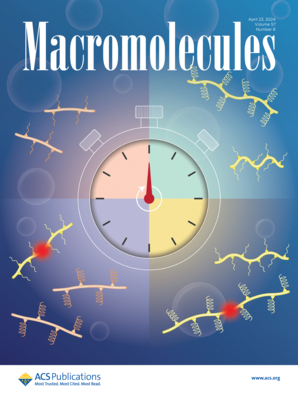Synergistic Impact of Intra- and Interchain Dispersity on Block Copolymer Self-Assembly
IF 5.1
1区 化学
Q1 POLYMER SCIENCE
引用次数: 0
Abstract
The effect of chain length dispersity on self-assembly behaviors of block copolymers was quantitatively investigated. Two sets of binary blends with precisely controlled compositions were prepared by mixing A-homopolymers into AB2 linear-branched block copolymers, where the two B branches were of either equal or unequal lengths. The added A-homopolymers swell the corona A domain, resulting in a generic phase transition sequence as the volume fraction varies. The distribution of the A-homopolymers depends critically on their length relative to that of the A-block of the copolymers. Longer homopolymers tend to localize at the vertices of the Voronoi cells, while shorter ones distribute more evenly in the corona domain. While blends consisting of A-homopolymers and symmetric linear-branched block copolymers exhibit exclusively the cylindrical phase, the addition of A-homopolymers to asymmetric counterparts leads to a richer array of ordered structures, including the Frank–Kasper phases, quasicrystalline phases, and the hexagonally close-packed phase. The combination of architectural asymmetry in the core (intrachain dispersity) and the presence of A-homopolymers in the corona (interchain dispersity) synergistically stabilizes these exotic structures, which could not be achieved when these two effects were present individually.

求助全文
约1分钟内获得全文
求助全文
来源期刊

Macromolecules
工程技术-高分子科学
CiteScore
9.30
自引率
16.40%
发文量
942
审稿时长
2 months
期刊介绍:
Macromolecules publishes original, fundamental, and impactful research on all aspects of polymer science. Topics of interest include synthesis (e.g., controlled polymerizations, polymerization catalysis, post polymerization modification, new monomer structures and polymer architectures, and polymerization mechanisms/kinetics analysis); phase behavior, thermodynamics, dynamic, and ordering/disordering phenomena (e.g., self-assembly, gelation, crystallization, solution/melt/solid-state characteristics); structure and properties (e.g., mechanical and rheological properties, surface/interfacial characteristics, electronic and transport properties); new state of the art characterization (e.g., spectroscopy, scattering, microscopy, rheology), simulation (e.g., Monte Carlo, molecular dynamics, multi-scale/coarse-grained modeling), and theoretical methods. Renewable/sustainable polymers, polymer networks, responsive polymers, electro-, magneto- and opto-active macromolecules, inorganic polymers, charge-transporting polymers (ion-containing, semiconducting, and conducting), nanostructured polymers, and polymer composites are also of interest. Typical papers published in Macromolecules showcase important and innovative concepts, experimental methods/observations, and theoretical/computational approaches that demonstrate a fundamental advance in the understanding of polymers.
 求助内容:
求助内容: 应助结果提醒方式:
应助结果提醒方式:


